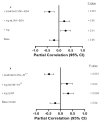Associations of Traditionally Determined Left Ventricular Mass Indices and Hemodynamic and Non-Hemodynamic Components of Cardiac Remodeling with Diastolic and Systolic Function in Patients with Chronic Kidney Disease
- PMID: 37445246
- PMCID: PMC10342723
- DOI: 10.3390/jcm12134211
Associations of Traditionally Determined Left Ventricular Mass Indices and Hemodynamic and Non-Hemodynamic Components of Cardiac Remodeling with Diastolic and Systolic Function in Patients with Chronic Kidney Disease
Abstract
We aimed to evaluate the extent to which different left ventricular mass parameters are associated with left ventricular function in chronic kidney disease (CKD) patients. We compared the associations between traditionally determined left ventricular mass indices (LVMIs) and hemodynamic (predicted LVMIs) and non-hemodynamic remodeling parameters with left ventricular function in patients with CKD; non-hemodynamic remodeling was represented by inappropriate left ventricular mass and inappropriate excess LVMIs (traditionally determined LVMIs-predicted LVMIs). Non-hemodynamic left ventricular remodeling parameters were strongly associated with impaired left ventricular systolic function (p < 0.001), whereas hemodynamic left ventricular remodeling was also related strongly (p < 0.001) but directly to left ventricular systolic function. Independent of one another, hemodynamic and non-hemodynamic left ventricular remodeling had associations in opposite directions to left ventricular systolic function and was associated directly with traditionally determined left ventricular mas indices (p < 0.001 for all relationships). Non-hemodynamic cardiac remodeling parameters discriminated more effectively than traditionally determined LVMIs between patients with and without reduced ejection fraction (p < 0.04 for comparison). Left ventricular mass parameters were unrelated to impaired diastolic function in patients with CKD. Traditionally determined LVMIs are less strongly associated with impaired systolic function than non-hemodynamic remodeling parameters (p < 0.04-0.01 for comparisons) because they represent both adaptive or compensatory and non-hemodynamic cardiac remodeling.
Keywords: chronic kidney disease; diastolic–systolic function; hemodynamic; non-hemodynamic cardiac remodeling components; traditionally determined left ventricular mass index.
Conflict of interest statement
The authors declare no conflict of interest.
Figures


Similar articles
-
Clinical aspects of left ventricular diastolic function assessed by Doppler echocardiography following acute myocardial infarction.Dan Med Bull. 2001 Nov;48(4):199-210. Dan Med Bull. 2001. PMID: 11767125 Review.
-
Association of the frontal QRS-T angle with adverse cardiac remodeling, impaired left and right ventricular function, and worse outcomes in heart failure with preserved ejection fraction.J Am Soc Echocardiogr. 2014 Jan;27(1):74-82.e2. doi: 10.1016/j.echo.2013.08.023. Epub 2013 Sep 27. J Am Soc Echocardiogr. 2014. PMID: 24075945 Free PMC article.
-
Aortic distensibility and arterial-ventricular coupling in early chronic kidney disease: a pattern resembling heart failure with preserved ejection fraction.Heart. 2008 Aug;94(8):1038-43. doi: 10.1136/hrt.2007.137539. Epub 2008 Feb 28. Heart. 2008. PMID: 18308865
-
Chronic kidney disease and cardiac remodelling in patients with mild heart failure: results from the REsynchronization reVErses Remodeling in Systolic Left vEntricular Dysfunction (REVERSE) study.Eur J Heart Fail. 2012 Dec;14(12):1420-8. doi: 10.1093/eurjhf/hfs135. Epub 2012 Sep 6. Eur J Heart Fail. 2012. PMID: 22956574 Free PMC article. Clinical Trial.
-
Associations among chronic kidney disease, high total p-cresylsulfate and left ventricular systolic dysfunction.Clin Chim Acta. 2016 Jun 1;457:63-8. doi: 10.1016/j.cca.2016.03.012. Epub 2016 Mar 29. Clin Chim Acta. 2016. PMID: 27036086
Cited by
-
Diabetic Nephropathy-Associated Impaired Aortic Function Is Not Mediated by Mean Arterial Pressure and Its Determinants.J Clin Med. 2024 Dec 21;13(24):7827. doi: 10.3390/jcm13247827. J Clin Med. 2024. PMID: 39768750 Free PMC article.
-
The relative potential contribution of volume load and vascular mechanisms to hypertension in non-dialysis and dialysis chronic kidney disease patients.Front Cardiovasc Med. 2024 Apr 15;11:1377887. doi: 10.3389/fcvm.2024.1377887. eCollection 2024. Front Cardiovasc Med. 2024. PMID: 38689863 Free PMC article.
-
Left atrial energy loss as a novel predictor of mortality and cardiovascular events in chronic kidney disease patients with preserved ejection fraction.BMC Cardiovasc Disord. 2025 Aug 4;25(1):577. doi: 10.1186/s12872-025-05058-z. BMC Cardiovasc Disord. 2025. PMID: 40759923 Free PMC article.
References
-
- Hickson L.J., Negrotto S.N., Onuigbo M., Scott C.G., Rule A.D., Norby S.M., Albright R.C., Casey E.T., Dillon J.J., Pellika P.A., et al. Echocardiography Criteria for Structural Heart Disease in Patients with End-Stage Renal Disease Initiating Haemodialysis. J. Am. Coll. Cardiol. 2016;67:1173–1182. doi: 10.1016/j.jacc.2015.12.052. - DOI - PMC - PubMed
Grants and funding
LinkOut - more resources
Full Text Sources

